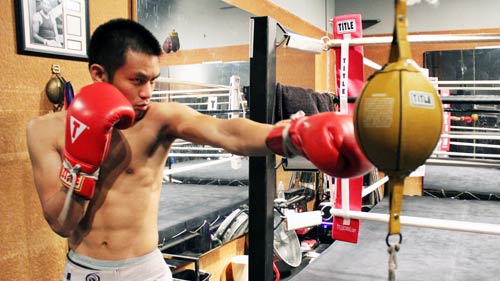
- Want to land knockout punches?
- Want to be a deadly puncher?
- Want to have faster combinations?
Every fighter NEEDS to train on the double-end bag!
But for some reason, it’s only the more advanced fighters that do it.
I’ll tell you why the pros do it and then I’ll tell you HOW to hit the double end bag.
What is the Double-End Bag?
The double-end bag, (also known as the floor-to-ceiling bag, or the “crazy bag” or “crazy ball”), is a small air-filled bag suspended at both ends to the ceiling and floor by a stretchy cord. Double-end bags will vary in size, shape, and rebound elasticity to offer you different types or different levels of punching skill workouts.
You typically have the following kinds of bag training:
Heavy bag – great for developing your power and conditioning. The bag swings around freely allowing you to use your legs as you move with the bag. The heavy bag has its limitations such as being too easy to hit and not giving you anything to react to. This is perhaps why beginners have the most fun on the heavy bag, because it’s easy to hit and feel amazing.
Speed bag – great for developing your rhythm, timing, hand speed, and endurance. It’s a great way to condition your shoulder muscles and arm muscles for throwing many punches without getting tired. The limitations of the speed bag is that it’s quite predictable to hit after a while and doesn’t challenge you to move around or be accurate. You can pretty much use the same motion over and over to hit the bag.
Double-end bag – something in between a heavy bag and a speed-bag depending on how you look at it. It’s similar to a heavy bag in that you can hit it with proper punching technique and also move around the bag. It’s similar to a speed-bag in that it requires rhythm and accuracy to hit.
The benefits of training on the double-end bag
The double-end bag is the perfect tool to develop your punching skills and overall boxing ability! Many experienced fighters love double-end bag training to develop their higher-level boxing skills.
Timing – the double-end bag isn’t just stationary like the heavy bag, it moves back and forth quickly (more realistic of an opponent’s head) making it more challenging to hit. Not only do you have to hit the bag but you have to hit it at the right time to make your punch effective.
Accuracy – the double-end bag is a smaller target that moves around a lot requiring you to use your eyes and be more accurate. It isn’t like the heavy bag which lays there waiting for you to hit it and making it easy for you to hit. The double-end bag will raise your accuracy especially if you can hit it with multiple punches in a row.
Rhythm – the double-end bag moves constantly back and forth requiring you to build up a rhythm in your punches instead of only throwing punches at awkward moments. Developing this rhythm in your body makes your fighting more effective and energy efficient in the ring.
Reflexes – This is what I love about the double-end bag so much. It forces you to use your eyes and be 100% aware of the double-end bag. It develops fast eyes and fast reflexes unlike the heavy bag which allows you to be land punches even when you’re lazy and mentally only half-awake. Skilled opponents move more like double-end bags than heavy bags.
Hand speed – the double-end bag moves quickly requiring you to use fast punches all the time in order to hit it. This is an important workout because many fighters get used to throwing slow punches on a stationary heavy bag and end up being too slow in a real fight to land punches.
Endurance – the double-end bag doesn’t bounce your hand back at you like the heavy bag, which means you’ll have to use more muscle to retract your arm, especially when you miss punches.
Power – punching power is not the same as punching skills. Good technique and conditioning can make you a more powerful puncher but you need punching skills (timing & accuracy) to actually transfer the power to your opponent. This is why many high-level fighters use the double-end bag. The heavy bag is also not so important for older fighters because their hands are worn down over the years. They rely on their punching skills rather than brute strength anyways.
The double-end bag develops your
timing, accuracy, rhythm, hand speed, endurance, and power.
Different kinds of double-end bags
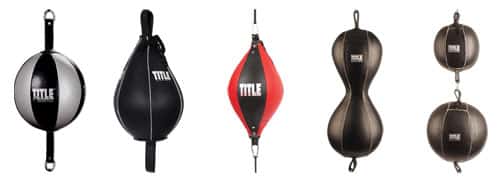
Recommended double-end bag setup for beginners:
- a single ball or pea shape (not a double-ball or peanut shape)
- not larger than 10″ in diameter
- positioned around shoulder height
- cords are elastic enough to make the double-end bag bounce back 2-4 feet when you hit it
- wear lighter gloves 12oz to 14oz
But if you have no choice, that’s fine too—use whatever your gym has.
Different variables in double-end bag setup:
- size (accuracy) – obviously a smaller ball will move faster and be harder to hit.
- shape (accuracy/punch-angles) – the shape of the double-end can force you to be more accurate with your punches. The shape can also allow for more punching angles. Some double-end bag shapes (pea shape) only allow straight punches and hooks whereas other shapes (ball shape) make it a little easier to hit with an uppercut. This isn’t a big deal because this training is mainly for timing, accuracy, and speed, not actual punching technique.
- 1-ball vs 2-ball shapes (head vs body punches) – some bags come with an “upper and lower” ball for you to practice your head and body punches. If you only have a single ball shape, you can still practice your body punches by hitting the cord
- cord elasticity (punching/defending rhythm) – this is probably the biggest variation. No gym will ever have the exact same cord elasticity and so every double-end bag setup will force you to train at a different rhythm. Generally speaking, using tight cords will keep the bag from moving too much. The bag will wiggle very quickly and force you to throw faster (and perhaps smaller) punches. Using very loose cords allows the bag to move all over the place making it more challenging to be accurate but at the same time, easier to time because you have more distance to aim your punches. A bag with very loose cords can also force you to slip because the bag will swing back enough to hit you. It’s not uncommon to see gyms with both a “tight double-end bag” as well as a “loose double-end bag”.
Double-end bags varying in size, shape, and cord elasticity
offer you different types of of punching skill workouts.
How to Hit the Double End Bag
*** Watch my video to see how I hit the double-end bag! ***
1. Start with small combinations (LLR or RRL)
Use small quick combinations
This is crucial but I see so many beginners doing it wrong. Don’t hit the bag so hard that it flies far away. This makes it hard for you to land a combo and impossible to get a steady rhythm going. Use small punches that don’t make the bag go back any further than 6 to 12 inches. It’s easier for you to control this way and develop quick fluid combinations. Start with combinations, rather than single power shots!
The double-end bag is more like a speed bag than a heavy bag.
Hit it with consistency, not power.
Hit with a LEFT-LEFT-RIGHT or RIGHT-RIGHT-LEFT rhythm
This is one of those things that changed my life but nobody ever taught me. Nobody that is, until Pepper Roach (Freddie Roach’s brother) came over and told me how to do it. It’s a great starting rhythm and will teach beginners how to understand the punching rhythm in boxing.
The reason why you use a left-left-RIGHT or right-right-LEFT rhythm is so that it teaches you how to chain big shots after small shots without breaking your rhythm. The first two punches are to help you find your opponent (the bag) which then sets him up for your final finishing “power shot”. The problem with beginners is that they’re always coming in with a power-punching mindset and trying to hit with a left-right-left-right rhythm which then becomes a slow rhythm without first setting up the “opponent”.
Again, throw 2 quick tapping shots with one hand, and then finish with a power shot on the other hand. (When I say “power”, I just mean like 50% power or even less….don’t hit it with everything you have or you’ll lose control and break your rhythm again.)
Double-end bag rhythm for beginners:
left-left-RIGHT or right-right-LEFT
Throw any punch you want
The double-end bag is about rhythm, timing, and accuracy more so than technique and strategy. This means you can throw any kind of punch you want and relax a bit. Sure, you can mimic realistic combinations like always start with the jab but I find double-end bag training to be more effective (and creative) when you start throwing experimental combinations.
For example if I use the LEFT-LEFT-RIGHT combination, I’m experimenting with all kinds of punches:
- jab-jab-cross
- jab-hook-cross
- hook-jab-cross
- uppercut-jab-croos
- uppercut-hook-cross
- uppercut-jab-uppercut
- etc
Likewise if I use the RIGHT-RIGHT-LEFT combination:
- uppercut-cross-jab
- uppercut-cross-hook
- cross-uppercut-hook
- cross-cross-hook
- etc, you get the point
Free your hands (free your mind), stand square if you like, break from your “perfect boxing stance” and loosen up your shoulders. Start developing a rhythm from all angles and with all punches.
2. Keep throwing (DON’T WAIT)
Do not wait for the bag
This is another one of those things every beginner does. They can’t hit the bag (maybe because they hit it too hard in the first place) and so they wait for it to stop moving before they hit it again. If you wait for the bag to stop, you’re defeating the point of double-end bag training–which is to build timing, rhythm, and accuracy. Generally speaking, you should throw the next combo 2-3 seconds after the previous combo.
Don’t wait for the double-end bag to slow down
before you throw the next combination.
Rely on the LLR or RRL rhythm
Again, this is where the LLR/RRL rhythm comes in handy. Let’s say the bag is moving too much and you can’t see it, let alone even hit the bag…the worst thing to do is to throw LEFT-RIGHT-LEFT-RIGHT rhythm because you will miss.
The smart thing is to throw a bunch of quick little punches from the same hand to help you control and “find” the bag which then sets up the real punch from the other hand. For example: if you throw multiple lefts, you will see that it’s easier to hit the bag, and even if you miss, the bag will come to one side of your hand…which then makes it easy for you to guess where to throw the right.
The LEFT-LEFT-RIGHT or RIGHT-RIGHT-LEFT rhythm
helps you hit a moving target.
Mix up your combos
Throw a LLR, then RRL, then LLR, maybe LLR again, maybe LLLLLR (because the bag was moving too much), then RRL, another RRL, RRRRRRL. Whatever you like. Use the base rhythm and then mix up your punches. Once you get the hang of hitting this crazy ball, you can break from the standard LLR/RRL rhythm and throw your typical combinations that you use on the heavy bag.
3. Move around in between combinations
Take one step after every combination
This was something one of my coaches stressed. Always take a step after every combination. It can be a step in any direction. It can be a linear step or a pivot. It can be big or small (preferably just a few inches) as long as you develop a rhythm of always being able to hit and move. Even if you throw a combination and shift one foot just slightly that will do you plenty good later in the ring.
After a while, you’ll be able to move your feet more often without feeling like you’re punching with lifted feet. For example, I’ll take small steps with my left hands, then throw a harder right hand, step over to one side, then come back with another combination. Other times, I’ll stay in place and use the [boxer’s bounce] with every punch. You should watch my video above to see how I punch and move at the same time.
Train on the double-end bag with a partner
One of the best ideas is to train on the bag with a partner. Take turns hitting the double-end bag so that when one guy finishes, the other starts immediately. This way, both of you will be forcing each other to raise the pace and always stay ready to punch. It’s a great way to push each to be faster, more aggressive, and more accurate. (Completely new beginners can also practice this drill on the heavy bag.)
Then, if you can, take steps while the other guy is punching. So when your partner is punching, you move (just 1 or 2 steps). Then when you punch, your partner is moving. You can quickly develop your hit-and-move skills very quickly this way. Again, don’t focus on power, focus on rhythm, timing, and accuracy!
Train on the double-end bag with a partner
to push each other to react faster.
The Ultimate Goal of Double-end Bag Training
Technique and conditioning gives you power.
Timing and accuracy allows you to use that power.
Throwing power punches is easy. (TECHNIQUE)
Landing power punches on a moving target is hard. (SKILLS)
Training on the double-end bag took my boxing skills and punching skills to a whole other level. I’m faster, sharper, more energy efficient. I know how to time my punches and I can throw quick snapping punches that land at the perfect time to do the most damage. I’m not just a better puncher but I’m also able to move better because I have more rhythm in my body (developed from skipping rope and double-end bag training).
There’s really no substitute for the double-end bag. And no, the reflex bag is terrible. I really don’t like that bag at all, it seems similar to the double-end bag but it feels so different. There’s a reason why the pros and higher skilled boxers rely on the double-end bag!
The next time you find yourself waiting for the heavy bag at the gym, go over to the double-end bag instead which is probably not being used. It might be humiliating at first because you can’t apply any of your macho strength to it but give it some time. Learn to relax and get a rhythm going and you’ll notice your punching skills improving faster than ever.
Training on the double-end bag has now become one of my many “resting exercises”. I’m always bouncing and hitting the double-end bag even when I’m talking to people at the gym or watching others spar. It’s a crucial piece of boxing equipment and you’d be cheating yourself by skipping it.
Other boxing guides on the double-end bag:





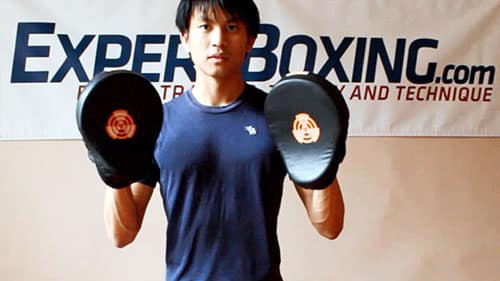
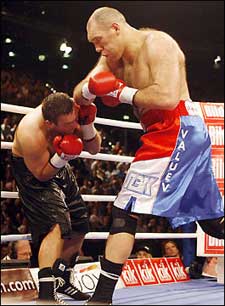
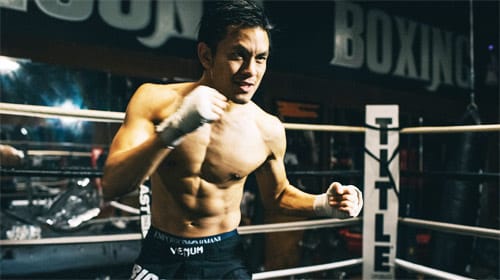
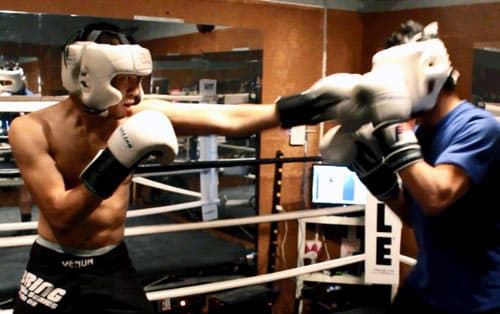
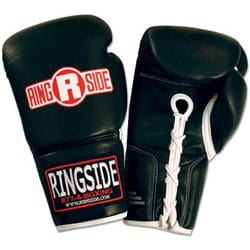

my favorite piece of equitment alongside the slip bag. so much benefits and just plain fun, doesnt beat up your hands, ofcourse feel the benefits of it in sparring and even on the mitts. got one in my garage so i never stop training without killing my body. just continue sharpening skills every hour by the hour, great thing about boxing is theres so many ways to improve skills technique without overtraining.
Great article and great explanations! I have a queston: what about the so called reflex bag? can I do the same exercises with reflex bag?
Thanks for your job!
I do not like the reflex bag. It’s nowhere near as effective and will not produce similar results. I’m sure you can do similar exercises with the reflex bag but it’s not the same.
what are angle bags for other than uppercuts
Probably the other punches as well.
Thanks for sharing!! Great Information!!
Also anything special about the cables? Do they need to be a special type?
Every gym has their own secret formula for the cables, usually something from the local hardware store.
La Habra has a really tight double end bag. I find it hard to do the LLR and RRL combos. I can do LRL combos with the last punch to the body. I guess I have to hit the bag faster and smaller, move more, and have a continuous flow of punches.
Yeaup! That’s how you do it on a tight bag. The DE bag at Wildcard gym is really tight, too.
Just put a double-ended bag up, and it certainly opens up a whole new avenue of training.
Good advice on using small punches at first.
I find that it’s much more realistic training than a heavybag, as far as speed, accuracy, timing, and defensive tactics are concerned
my new trainor wants me to use heavy punches on the heavy bag. i know its wrong but when i do what youve said, he is correcting me about it. what will I do about this problem, when he didnt know how to hit it properly, how can i train using your methods if this is the case 🙁
My methods is one way of way of approaching training. Your trainer comes from a different angle. Do both, and then find out your own method. We are here to give guidance.
What do you think about double-end bag with tennis ball??
Try it and see if you like it. I use a conventional double-end bag and I’m pretty happy with that.
Hi Johhny. Great guide as always. i have a question. Do you use your gloves on the bag or not? I have been hitting the bag without it since I started it but I’m just not sure. Thanks.
I always wear gloves on the bag.
what are your thoughts on attaching two single bags together to get a double bag shape? looking on the internet I can get two high quality singles for a fraction of the price of a good double… or am i missing something!?
I don’t see why not. But you’re right, I’ve never seen anybody try out your idea before.
Johnny,
I’m interested in getting a double end bag so that I can replace the one at my local golds when I’m training which is pretty crappy, but I’ve never set one of these up and haven’t seen anything online to guide me through it. Any chance you could offer some instructions? Great site btw.
Everyone has their own method. Some people purchase their double-end bags already with a mounting kit. Other people look at their set-up (ceiling & floor) and then go to the hardware store to buy whatever kind of mounting gear they want. You can also go to a local gym and see what they use and copy.
I bought my first double end bag today and didn’t have a clue how to use it until I watched your clip. Great fun ,tricky but i got a good few punches in after a while .Your very good at explaining things johnny ,Nice one. Peace be with you bro.
Dodo..
Hi johnny I have a question. Is it ok if I tie a knot or two on the bungee cord to adjust the height? Because my ceiling is quite low which means the bungee cord is to long.
Yes, you can tie knots in the cord to shorten it. We do that at my gym, too. My advice is to put the knot at the ends, either way close to the bag or close to the ceiling/wall. This way, the cord is unkinked in the middle and has a consistent flowing stretch all throughout.
Johnny: Thanks for the video/blog. I just got a double-end bag a couple weeks ago and wow! I felt very inept at first, couldn’t find a rhythm, kept missing. After a while though, I started to be able to do rr-l ll-r combos with some consistency. it gives me a much better appreciation/preparation for fighting as it activates the muscles more readily and I miss more so can feel myself tiring in a more realistic way than I would on the heavy bag, if that makes any sense? Question: Which of your for sale tutorials would be most helpful for me now that I am about 7 months in? Thanks for site, it is treasure trove for noobs like me!
Hi Tim,
I’m so glad you discovered the fun of the double-end bag. I don’t know how effective your trainer is but at 7 months in, I would feel comfortable recommending all my products to you. The Advanced Boxing Workshop may perhaps be a little too advanced for you right now, though. But the other stuff is great for beginners.
Hi, so I am cluless when it comes to boxing but I would love for some help, the guy I’m seeing boxes he does not have a double ended bag in his small workout studio so I thought it’d be a great christmas gift for him, however I have no idea what a good double end bag would be if anyone could help me out that would be greatly appreciated I’m also open to any other gift ideas that a boxer would love. I hope to hear back from someone thanks!
Check out titleboxing.com and pick one of the medium or small-sized ones.
I just started boxing a week ago @ 21 years old. I’ve wanted to since I was probably 12, so i’m real excited, used to have a double end bag and it was extremely lose, now the one in my gym is almost flat and very tight, my hand barely moves it and it doesn’t bounce, almost useless to me nobody really goes on it I’ll have to pay more attention, besides a few kids. Definitely wanna try this bad larry out
Hi, so I am cluless when it comes to boxing but I would love for some help, the guy I’m seeing boxes he does not have a double ended bag in his small workout studio so I thought it’d be a great christmas gift for him, however I have no idea what a good double end bag would be if anyone could help me out that would be greatly appreciated I’m also open to any other gift ideas that a boxer would love. I hope to hear back from someone 🙂 thanks!
Check out titleboxing.com and pick one of the medium or small-sized ones.
Hey Johnny,
What do you prefer a tight cord or a loose cord for a double end bag, and whats the pros and cons of each?
Hey Johnny, can u make a video on what
What to do when a boxer throws more than
One punch, they don’t admire the first one
I always find my self trap leaning side ways
And always get hit with left hooks step to the
Right works but I get jab jab and cross
You have to be careful about how slip. One you give up your center, it’s hard to get it back unless you use a counter. Check out my guides and videos on boxing head movement, slipping, and the 3 axes.
Hi Luke, I explained the different up above in the part called “cord elasticity”. Take a look and let me know if you still have questions.
Great post!
what is best? 2 rubbers cord or 1 nylon and 1 rubber?? There is different tensions for different objectives??
Mine spins aroung alot… It is me or the set up?
Thank you
I just made my own double end bag at home by attaching a tennis ball to two cords. It is hard to catch because of the small target.
Hope it is o.k. To train with it.
I hung my double end bag sideways. What are the benefits, if any of hanging it horizontally as opposed to the conventional vertical way?
Hi Johnny, I’ve started using this bag, and it gives my arms a really good workout, I do other arts also, and I was wandering if I can only use it once a week and I box once a week due to my shift pattern, how long should I spend on the double ended bag, as I usually have 2 hours spare to train this area.
I’d say get the smallest size since that’s the most challenging. That’s what I did when I picked up my 6” title double end bag.
PLease johnny could you help me to choose size speedbag? there are s, xs,l size and m but i don’t know how choose… i’m 66kg weight and 1M77 size ,can you explain me speedbag utility,workbody and exercise for every size and in general and how speed bag you think i ave to buy?
And I want to buy a double speed bag, I thought buy with two balls, it’s better than one isn’t it??
Sincerely
This is something you have to figure out for yourself. Go to a gym and try out different options and see what you like best.
Hey Johnny,
Do you find it’s better to adjust your stance when practicing with the DE bag? I’m typically standing more perpendicular so I can get some length on my left jab and twist to get power for my straight right, but I’ve been told that for speed and DE bag, it’s better to be more square to the bag so you can fire off the punches quicker. Would you say that this is the best way to stand for the smaller, speed-oriented bags?
Thanks for all the help!
Fighters are definitely more square in general for the DE bag. You’re there to work on coordination and timing, not punching form. But it also depends which drills you’re doing. If you’re mimicking realistic movements, ok adjust for it. If you’re working on pure speed and timing then adjust for it. If you want more length on the jab, work on that in shadowboxing.
what are your opinions on hitting the end bag without gloves? This is what my gym does.
That’s ok, too if you don’t mind that your timing is a little different than with gloves on. It can help you practice aiming better since your hands are smaller than a glove. To avoid scraping your skin, you might want a bag glove or handwraps, or even gel-wraps (probably the only instance where I would recommend a gel-wrap).
I want to buy a punching bag for home use. My focus is on exercise, but I do plan to follow training videos and articles. I had planned to get a heavy bag, but now I’m wondering if I should get a double-end bag instead. What’s your opinion? Should I get a heavy bag, and later incorporate a DE bag, or skip the heavy bag altogether? Thanks!
unfortunately I can not have this material at home, I would like to know your opinion about reflex ball, thank you for everything you do
Hi Johnny,
I recently got a double end bag, and your article was by far the best advice I got. Especially about not necessarily sticking to standard jab/cross sequences; by mixing up punches I found rhythm and was more accurate. I guess not all are ‘correct’ punches, some backhands and haymakers- is that alright? The other thing is, can you move in between a combo or only after the combo is done?
Due to overseas import, delays may occur when power generation is practiced or accessories may be crushed at the shipping stage. In some cases, the size chart of the ring The size chart on the product page is a general size converted from overseas size to Japanese size, and the size may differ depending on the manufacturer’s product. Please use the size chart as a reference.